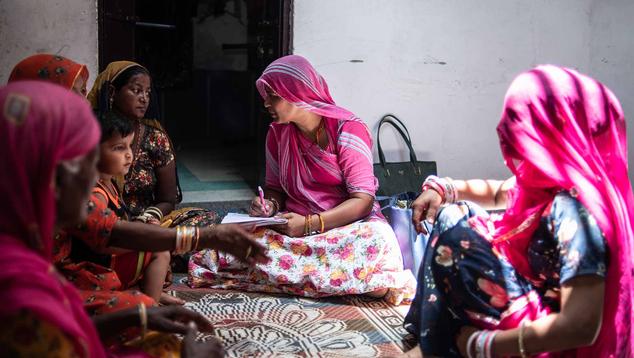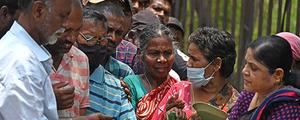Story Highlights
- Majority of Indians perceive climate change as a threat
- Big regional variations exist in how threatened people feel
- Indians more satisfied than ever with efforts to preserve the environment
This is the third article in a three-part series on the opportunities and challenges facing India, which recently overtook China as the most populous country in the world.
WASHINGTON, D.C. -- How India adapts to climate change will be critical for its future growth and success. A recent United Nations Intergovernmental Panel on Climate Change (IPCC) report painted a bleak picture for the world’s newly minted most populous country, which faces several major threats from a changing climate that are already transforming India in profound ways.
Here are four key takeaways from Gallup’s data and the Lloyd’s Register Foundation World Risk Poll's data on how Indians view their natural environment and climate change.
1. The majority of Indians see climate change as a potential threat, but the perceived threat varies by region. Roughly three in five Indians (62%) perceive climate change as a threat to their country in the next 20 years -- with 37% seeing it as a “very serious” threat -- according to data aggregated from the 2019 and 2021 Lloyd’s Register Foundation World Risk Poll.
But these perceptions vary by region. Indians living in the coastal state of Kerala feel the most threatened by climate change, with 92% of people seeing it as a serious threat in coming decades. Kerala is notably India’s most literate state and highly vulnerable to the effects of climate change such as flooding and landslides. People living there are also the most likely to express any opinion on climate change. Two percent of Keralans “don’t know” if climate change is a threat to their country.
By contrast, people in Assam and Madhya Pradesh are least concerned about climate change. In both states, minorities of residents feel threatened by climate change.
While many factors influence people’s attitudes toward climate change, the association with education is clearly illustrated at a state-by-state level. The higher the level of education in a state, the more threatened by climate change its population feels.
As literacy rates continue to increase in India, and the effects of climate change become more readily apparent to vast swaths of the population, it is possible that concern will grow further in coming years.
2. Nearly one in five currently do not perceive climate change as a potential threat. There is still a substantial section of the Indian population (18%) who see climate change as “not a threat at all.” This places India second only to Pakistan in South Asia for not seeing climate change as a threat in the 2021 World Risk Poll. A further 20% do not know whether climate change is a threat to India.
Not seeing climate change as a threat extends across demographic groups irrespective of gender, age, income or employment status. Even though there is a clear link between education and concern about climate change, there is still a sizable proportion (14%) of the most-educated group in India who do not see climate change as a threat.
3. Indians are more satisfied than ever with efforts to preserve the environment. In 2022, more Indians (85%) were satisfied with efforts to protect their country's natural environment than Gallup has previously measured since 2006, despite the numerous environmental threats they face. Compared globally, India ranks in the top 10 countries for highest satisfaction with environmental protection.
India’s environmental policy centers on protecting regional glaciers, reducing plastic use, producing clean cooking fuel and making the railway system more sustainable. Significant progress has also been made in expanding renewable energy capacity.
While the 2022 IPCC report noted that India performs well on emissions per capita compared with other major economies, others claim India is still not doing enough to protect the environment, particularly in its continued reliance on coal power.
Worldwide in 2021, there was a negative relationship between perceiving climate change as a very serious threat and being satisfied with environmental protection.
India is on a similar footing to other Asia-Pacific countries such as China, Indonesia, Laos, Cambodia and Bangladesh, where majorities of people are satisfied with environmental protection efforts, but minorities perceive climate change as a very serious threat.
4. Indians are highly satisfied with air and water quality, but risk is spread unevenly. Despite the challenges India faces from water scarcity, flooding and air pollution, most people were satisfied with the quality of their air (90%) and water (79%) in 2022. However, access to clean water is highly uneven in India.
According to the 2021 World Risk Poll, nearly one in four (23%) Indians were “very worried” that the water they drink could cause them serious harm. The poorest 20% of society were twice as likely to be very worried about their drinking water as the richest 20% were (28% versus 14%, respectively). Similarly, the poorest were much more likely to have been without clean drinking water at some point in the previous year (41% versus 21%).
Bottom Line
In the face of such widespread climate threats, India aims to reach net-zero greenhouse gas emissions by 2070, at which point its population is projected to exceed 1.6 billion. As its population and economy continue to grow, it will seek to maintain its good track record on low emissions per capita, relative to other major economies. The extent to which India expands or reduces its domestic coal production will be pivotal in determining the country's ability to change as the climate does.
There is still much more to do in raising awareness about the threat of climate change, particularly among the least educated and most vulnerable, who often find themselves most at risk from its negative effects.
Read Gallup's India Briefing (PDF download).
To stay up to date with the latest Gallup News insights and updates, follow us on Twitter.
For complete methodology and specific survey dates, please review Gallup's Country Data Set details.
Learn more about how the Gallup World Poll works.
Find out more about the Lloyd’s Register Foundation World Risk Poll.




